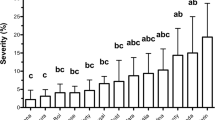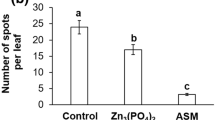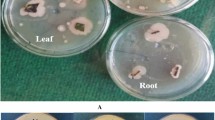Abstract
This study aimed to evaluate the effectiveness of exopolysaccharides (EPS) produced by Lactobacillus plantarum in controlling bacterial spot and eliciting defense mechanisms, and verify alterations in the tomato plant physiological responses. Tomato plants with five definitive leaves were sprayed with EPS, acibenzolar-S-methyl (ASM, positive control), or distilled water (negative control) and inoculated with Xanthomonas gardneri after 3 days. Local and systemic protection was evaluated 7, 15, and 21 days after inoculation. Biochemical defense mechanisms (peroxidases [POX], polyphenoloxidases [PPO], catalase [CAT], superoxide dismutase [SOD], accumulation of hydrogen peroxide [H2O2], and physiological changes) were quantified. In addition, histochemical analyses were examined through light and fluorescence microscopy in treated tomato plants, inoculated or not with X. gardneri. On average, EPS and ASM provided 55 and 96% reduction, respectively, of the bacteriosis severity in treated leaves, compared to the control plants. Increased activities of PPO, CAT, and SOD were found in the EPS-treated plants after being challenged with the pathogen. ASM caused increases in all enzymes analyzed, especially in inoculated plants. The rate of photosynthesis was three times higher, while stomatal conductance and transpiration were 36% lower in the plants sprayed with EPS and challenged with the pathogen, compared to the inoculated control plants. The photochemical efficiency and Soil Plant Analysis Development (SPAD) index did not change. Under light and fluorescence microscopy, it could be seen accumulation of cellulosic compounds in the epidermis of the leaves treated with EPS. Therefore, application of EPS can be considered an alternative for the control of bacterial spot in tomato plants. The study discusses how biochemical and physiological alterations caused by the polysaccharide in the plants contributed to reduce the severity of the disease.



Similar content being viewed by others
References
Araújo E, Costa JR, Pontes N, Quezado-Duval AM (2015) Xanthomonas perforans and X. gardneri associated with bacterial leaf spot on weeds in Brazilian tomato fields. Eur J Plant Pathol 143(3):543–548. https://doi.org/10.1007/s10658-015-0705-9
Ausubel FM (2005) Are innate immune signaling pathways in plants and animals conserved? Nat Immunol 6(10):973–979. https://doi.org/10.1038/ni1253
Baker B (2008) Chlorophyll fluorescence: a probe of photosynthesis in vivo. Annu Rev Plant Biol 59:89–113. https://doi.org/10.1146/annurev.arplant.59.032607.092759
Baker NR, Oxborough K (2004) Chlorophyll fluorescence as a probe of photosynthetic productivity. In: Papageorgiou GC, Govindjee (eds) Chlorophyll a fluorescence. Advances in photosynthesis and respiration, vol 19. Spinger, Berlin, pp 65–82. https://doi.org/10.1007/978-1-4020-3218-9_3
Baque MA, Moh SH, Lee EJ, Zhong JJ, Paek KY (2012) Production of biomass and useful compounds from adventitious roots of high-value added medicinal plants using bioreactor. Biotechnol Adv 30:1255–1267. https://doi.org/10.1016/j.biotechadv.2011.11.004
Beckers GJ, Conrath U (2007) Priming for stress resistance: from the lab to the field. Curr Opin Plant Biol 10(4):425–431. https://doi.org/10.1016/j.pbi.2007.06.002
Bitter R, Mohiuddin T, Nawrocki M (2000) Labview: advanced programming techniques, 1st edn. CRC Press, Boca Raton, p 525
Bouzon ZL, Schmidt EC (2011) Microscopia Vegetal. In: Ribeiro CAO, Reis Filho HS, Grötzner SR (eds) Técnicas e métodos para utilização prática de microscopia, 1st edn. Editora Santos/Editora Guanabara Koogan, Rio de Janeiro, pp 383–399
Bradford MM (1976) Rapid and sensitive method for quantitation of microgram quantities of protein utilizing principle of protein-dye binding. Anal Biochem 72(1–2):248–254
Camelini CM, Rezzadori K, Benedetti S, Proner MC, Fogaça L, Azambuja AA, Giachini A, Rossi MJ, Petrus JC (2013) Nanofiltration of polysaccharides from Agaricus subrufescens. Appl Microbiol Biotechnol 97(23):9993–10002. https://doi.org/10.1007/s00253-013-5241-y
Conrath U (2011) Molecular aspects of defence priming. Trends Plant Sci 16(10):524–531. https://doi.org/10.1016/j.tplants.2011.06.004
Conrath U, Pieterse CMJ, Mauch-Mani B (2002) Priming in plant—pathogen interactions. Trends Plant Sci 7(5):210–216. https://doi.org/10.1016/S1360-1385(02)02244-6
Csinos AS, Pappu RH, McPherson RM, Stephenson MG (2001) Management of tomato spotted wilt virus in flue-cured tobacco with acibenzolar-S-methyl and imidacloprid. Plant Dis 85(3):292–296. https://doi.org/10.1094/PDIS.2001.85.3.292
Das D, Goyal A (2014) Characterization and biocompatibility of glucan: a safe food additive from probiotic Lactobacillus plantarum DM5. J Sci Food Agric 94(4):683–690. https://doi.org/10.1002/jsfa.6305
Duangmal K, Apenten RKO (1999) A comparative study of polyphenoloxidases from taro (Colocasia esculenta) and potato (Solanum tuberosum var. Romano). Food Chem 64:351–359. https://doi.org/10.1016/S0308-8146(98)00127-7
Erbs G, Silipo A, Aslam S, De Castro C, Liparoti V, Flagiello A, Pucci P, Lanzetta R, Parrilli M, Molinaro A, Newman MA, Cooper RM (2008) Peptidoglycan and muropeptides from pathogens Agrobacterium and Xanthomonas elicit plant innate immunity: structure and activity. Chem Biol 15(5):438–448. https://doi.org/10.1016/j.chembiol.2008.03.017
Fridovich I (1975) Superoxide dismutases. Annu Rev Biochem 44:147–159. https://doi.org/10.1146/annurev.bi.44.070175.001051
Gayler S, Leser, Priesack E, Treutter D (2004) Modelling the effect of environmental factors on the “trade-off” between growth and defensive compounds in young apple trees. Trees 18(3):363–371. https://doi.org/10.1007/s00468-003-0315-6
Gill SS, Tuteja N (2010) Reactive oxygen species and antioxidant machinery in abiotic stress tolerance in crop plants. Plant Physiol Biochem 48(12):909–930. https://doi.org/10.1016/j.plaphy.2010.08.016
Grimmer MK, Foulkes MJ, Paveley ND (2012) Foliar pathogenesis and plant water relations: a review. J Exp Bot 63(2):695–709. https://doi.org/10.1093/jxb/ers143
Gudesblat GE, Torres PS, Vojnov AA (2008) Xanthomonas campestris overcomes Arabidopsis stomatal innate immunity through a DSF cell-to-cell signal-regulated virulence factor. Plant Physiol 149(2):1017–1027. https://doi.org/10.1104/pp.108.126870
Hael-Conrad V, Abou-Mansour E, Díaz-Ricci JC, Métraux JP, Serrano M (2015) The novel elicitor AsES triggers a defense response against Botrytis cinerea in Arabidopsis thaliana. Plant Sci 241:120–127. https://doi.org/10.1016/j.plantsci.2015.09.025
Hammerschmidt R, Kuc J (1982) Lignification as a mechanism for induced systemic resistance in cucumber. Physiol Plant Pathol 20(1):61–71. https://doi.org/10.1016/0048-4059(82)90024-8
Hammerschmidt R, Nuckles EM, Kuc J (1982) Association of enhanced peroxidase activity with induced systemic resistance of cucumber to Colletotrichum lagenarium. Physiol Plant Pathol 20(1):73–82. https://doi.org/10.1016/0048-4059(82)90025-X
He P, Shan L, Sheen J (2007) Elicitation and suppression of microbe-associated molecular pattern-triggered immunity in plant-microbe interactions. Cell Microbiol 9(6):1385–1396. https://doi.org/10.1111/j.1462-5822.2007.00944.x
Henriques FS (2009) Leaf chlorophyll fluorescence: background and fundamentals for plant biologists. Bot Rev 75(3):249–270
Huseynova IM, Sultanova NF, Aliyev JA (2014) Histochemical visualization of ROS and antioxidant response to viral infections of vegetable crops grown in Azerbaijan. Plant Physiol Biochem 81:26–35. https://doi.org/10.1016/j.plaphy.2014.03.002
Jebara S, Jebara M, Limam F, Aouani ME (2005) Changes in ascorbate peroxidase, catalase, guaiacol peroxidase and superoxide dismutase activities in common bean (Phaseolus vulgaris) nodules under salt stress. J Plant Physiol 162(8):929–936. https://doi.org/10.1016/j.jplph.2004.10.005
Jones JD, Dangl JL (2006) The plant immune system. Nature 444:323–329. https://doi.org/10.1038/nature05286
Kang NJ (2008) Inhibition of powdery mildew development and activation of antioxidant enzymes by induction of oxidative stress with foliar application of a mixture of riboflavin and methionine in cucumber. Sci Hortic 118(3):181–188, 102
Krause GH, Weis A (1991) Chlorophyll fluorescence and photosynthesis: the basics. Annu Rev Plant Biol 42:313–349
Lee S, Choi H, Suh S, Doo IS, Oh KY, Choi EJ, Schroeder Taylor AT, Low PS, Lee Y (1999) Oligogalacturonic acid and chitosan reduce stomatal aperture by inducing the evolution of reactive oxygen species from guard cells of tomato and Commelina communis. Plant Physiol 121(1):147–152
Leemhuis H, Pijning T, Dobruchowska JM, van Leeuwen SS, Kralj S, Dijkstra BW, Dijkhuizen L (2013) Glucansucrases: three-dimensional structures, reactions, mechanism, α-glucan analysis and their implications in biotechnology and food applications. J Biotechnol 163(2):250–272. https://doi.org/10.1016/j.jbiotec.2012.06.037
Lemos-Blainski JM, Rocha Neto AC, Luiz C, Rossi MJ, Di Piero RM (2017) Lactobacillus plantarum exopolysaccharides induce resistance against tomato bacterial spot. J Agric Sci 9(2):162–179. https://doi.org/10.5539/jas.v9n2p162
Logemann E, Wu SC, Schröder J, Schmelzer E, Somssich IE, Hahlbrock K (1995) Gene activation by UV light, fungal elicitor or fungal infection in Petroselinum crispum is correlated with repression of cell cycle-related genes. Plant J 8:865–878
Louws FJ, Wilson M (2001) Field control of bacterial spot and bacterial speck of tomato using a plant activator. Plant Dis 85(5):481–488. https://doi.org/10.1094/PDIS.2001.85.5.481
Luiz C, Felipini RB, Costa MEB, Di Piero RM (2012) Polysaccharides from Aloe barbadensis reduce the severity of bacterial spot and activate disease-related proteins in tomato. J Plant Pathol 94(2):387–393. https://doi.org/10.4454/JPP.FA.2012.046
Luiz C, Rocha Neto AC, Di Piero RM (2015) Resistance to Xanthomonas gardneri in tomato leaves induced by polysaccharides from plant or microbial origin. J Plant Pathol 97(1):119–127. https://doi.org/10.4454/JPP.V97I1.029
Mandal SM, Chakraborty D, Dey S (2010) Phenolic acids act as signalling molecules in plant-microbe symbioses. Plant Signal Behav 5(4):359–368. https://doi.org/10.4161/psb.5.4.10871
Mandal S, Kar I, Mukherjee AK, Acharya P (2013) Elicitor-induced defense responses in Solanum lycopersicum against Ralstonia solanacearum. Sci World J 2013:1–10. https://doi.org/10.1155/2013/561056
Mello SCM, Takatsu A, Lopes CA (1997) Escala diagramática para avaliação da mancha bacteriana do tomateiro. Fitopatol Bras 22:447–448
Melotto M, Underwood W, Koczan J, Nomura K, He SY (2006) Plant stomata function in innate immunity against bacterial invasion. Cell 126(5):969–980. https://doi.org/10.1016/j.cell.2006.06.054
Mohammadi M, Kazemi H (2002) Changes in peroxidase and polyphenol oxidase activities in susceptible and resistant wheat heads inoculated with Fusarium graminearum and induced resistance. Plant Sci 162(4):491–498. https://doi.org/10.1016/S0168-9452(01)00538-6
Notararigo S, Nácher-Vázquez M, Ibarburu I, Werning ML, de Palencia PF, Dueñas MT, Aznar R, López P, Prieto A (2013) Comparative analysis of production and purification of homo- and hetero-polysaccharides produced by lactic acid bacteria. Carbohydr Polym 93(1):57–64. https://doi.org/10.1016/j.carbpol.2012.05.016
Obradovic A, Jones JB, Momol MT, Olson SM, Jackson LE, Balogh B (2005) Integration of biological control agents and systemic acquired resistance inducers against bacterial spot on tomato. Plant Dis 89(7):712–716. https://doi.org/10.1094/PD-89-0712
Patel S, Majumder A, Goyal A (2012) Potentials of exopolysaccharides from lactic acid bacteria. Indian J Microbiol 52(1):3–12. https://doi.org/10.1007/s12088-011-0148-8
Peixoto PHP, Cambraia J, Sant’anna R, Mosquim PR, Moreira MA (1999) Aluminum effects on lipid peroxidation and on the activities of enzymes of oxidative metabolism in sorghum. Rev Bras Fisiol Veg 11(3):137–143
Prats E, Rubiales D, Jorrín J (2002) Acibenzolar-S-methyl induced resistance to sunflower rust (Puccinia helianthi) is associated with an enhancement of coumarins on foliar surface. Physiol Mol Plant Pathol 60(3):155–162. https://doi.org/10.1006/pmpp.2002.0385
Proietti S, Giangrande C, Amoresano A, Pucci P, Molinaro A, Bertini L, Caporale C, Caruso C (2014) Xanthomonas campestris lipooligosaccharides trigger innate immunity and oxidative burst in Arabidopsis. Plant Physiol Biochem 85:51–62. https://doi.org/10.1016/j.plaphy.2014.10.011
Quan LJ, Zhang B, Shi WW, Li HY (2008) Hydrogen peroxide in plants: a versatile molecule of the reactive oxygen species network. J Integr Plant Biol 50(1):2–18. https://doi.org/10.1111/j.1744-7909.2007.00599.x
Rezende DC (2014) Fosfito de potássio no controle de Phytophthora spp. em citros e faia e seu modo de ação. Doctoral Thesis, Escola Superior de Agricultura Luiz de Queiroz, University of São Paulo, Piracicaba. doi:https://doi.org/10.11606/T.11.2015.tde-28042015-134251. Retrieved 2018-01-22, from www.teses.usp.br
Schmidt EC, Scariot LA, Rover T, Bouzon ZL (2009) Changes in ultrastructure and histochemistry of two red macroalgae strains of Kappaphycus alvarezii (Rhodophyta, Gigartinales), as a consequence of ultraviolet B radiation exposure. Micron 40(8):860–869. https://doi.org/10.1016/j.micron.2009.06.003
Seleim MA, Abo-Elyousr KA, Mohamed AA, Al-Marzoky HA (2014) Peroxidase and polyphenoloxidase activities as biochemical markers for biocontrol efficacy in the control of tomato bacteria. J Plant Physiol Pathol 1:8–11. https://doi.org/10.4172/2329-955X.1000117
Seo B, Bajpai VK, Rather IA, Park Y (2015) Partially purified exopolysaccharide from Lactobacillus plantarum YML009 with total phenolic content , antioxidant and free radical scavenging efficacy. Pharm Res 49(4):282–292. https://doi.org/10.5530/ijper.49.4.6
Silva CMMS, Fay EF (2006) Impacto ambiental do fungicida, metalaxil. edn. Embrapa Meio Ambiente, Jaguariúna, p 96
Silva RA, Reis VM, Baldani JI, Olivares FL (2008) Defesa de plantas contra o ataque de fitopatógenos. Embrapa Agrobiologia, Seropédica, p 49
Silva VA, Salgado SML, Sá LA, Reis AM, Silveira HRO, Mendes ANG, Barbosa JPRAD, Pereira AA (2015) Uso de características fisiológicas na identificação de genótipos de café arábica tolerantes ao Meloidogyne paranaenses. Coffee Sci Lavras 10(2):242–250
Stangarlin JR, Kuhn OJ, Toledo MV, Portz RL, Schwan-Estrada KRF, Pascholati SF (2011) A defesa vegetal contra fitopatógenos. Sci Agrar Paranaen 10(1):18–46
Statsoft 2007 Electronic statistics textbook. Tulsa, USA. Online http://www.omafra.gov.on.ca
Suzuki K, Nishiuchi T, Nakayama Y, Ito M, Shinshi H (2006) Elicitor-induced down-regulation of cell cycle-related genes in tobacco cells. Plant Cell Environ 29(2):183–191. https://doi.org/10.1111/j.1365-3040.2005.01411.x
Tang Y, Dong W, Wan K, Zhang L, Li C, Zhang L, Liu N (2015) Exopolysaccharide produced by Lactobacillus plantarum induces maturation of dendritic cells in BALB/c mice. PLoS 10(11):1–16. https://doi.org/10.1371/journal.pone.0143743
Thordal-Christensen H, Zhang Z, Wei Y, Collinge DB (1997) Subcellular localization of H2O2 in plants. H2O2 accumulation in papillae and hypersensitive response during the barley-powdery mildew interaction. Plant J 11:1187–1194. https://doi.org/10.1046/j.1365-313X.1997.11061187.x
Vaughn KC, Duke SO (1984) Function of polyphenol oxidase in higher plants. Physiol Plant 60:106–112. https://doi.org/10.1111/j.1399-3054.1984.tb04258.x
Walters DR, Ratsep J, Havis ND (2013) Controlling crop diseases using induced resistance: challenges for the future. J Exp Bot 64(5):1263–1280. https://doi.org/10.1093/jxb/ert026
Welman AD, Maddox IS (2003) Exopolysaccharides from lactic acid bacteria: perspectives and challenges. Trends Biotechnol 21(6):269–274. https://doi.org/10.1016/S0167-7799(03)00107-0
Wittstock U, Gershenzon J (2002) Constitutive plant toxins and their role in defense against herbivores and pathogens. Curr Opin Plant Biol 5(4):300–307
Zhang J, Zhou JM (2010) Plant immunity triggered by microbial molecular signatures. Mol Plant 3(5):783–793. https://doi.org/10.1093/mp/ssq035
Acknowledgements
Our thanks to the Coordination of Development of High Education Personnel (CAPES) for awarding fellowships, to Sakata for the bacterial isolate and to Dr. Alice M. Quezado-Duval, EMBRAPA, for the identification of the pathogen, and to Dr. Zenilda Bouzon for ceding equipment and reagents for microscopy.
Funding
This study was funded by the Coordination of Development of High Education Personnel (CAPES) with awarding fellowships. The recipient is Juliane Mendes Lemos Blainski.
Author information
Authors and Affiliations
Corresponding authors
Ethics declarations
This article does not contain any studies with human participants or animals performed by any of the authors.
Conflict of interest
All authors declare that they do not have a conflict of interest.
Rights and permissions
About this article
Cite this article
Blainski, J.M.L., da Rocha Neto, A.C., Schimidt, E.C. et al. Exopolysaccharides from Lactobacillus plantarum induce biochemical and physiological alterations in tomato plant against bacterial spot. Appl Microbiol Biotechnol 102, 4741–4753 (2018). https://doi.org/10.1007/s00253-018-8946-0
Received:
Revised:
Accepted:
Published:
Issue Date:
DOI: https://doi.org/10.1007/s00253-018-8946-0




